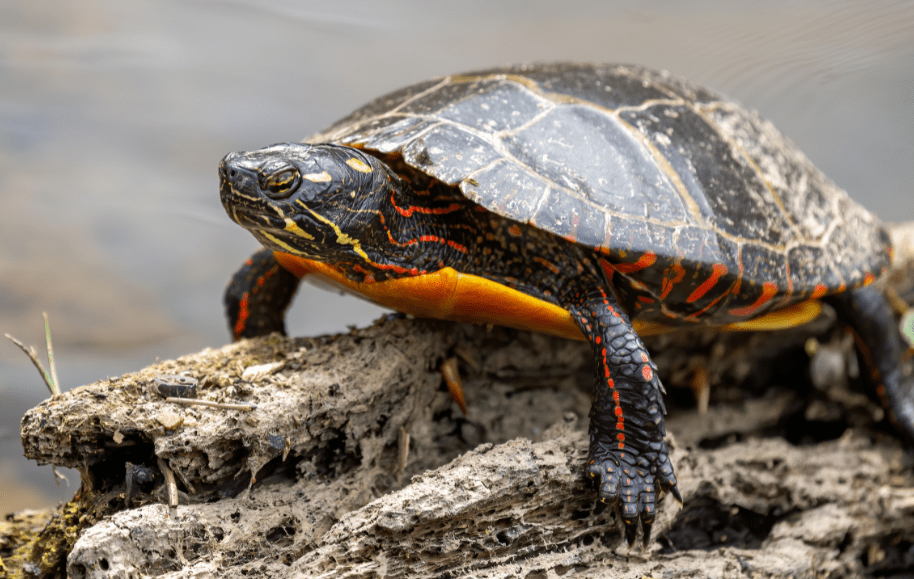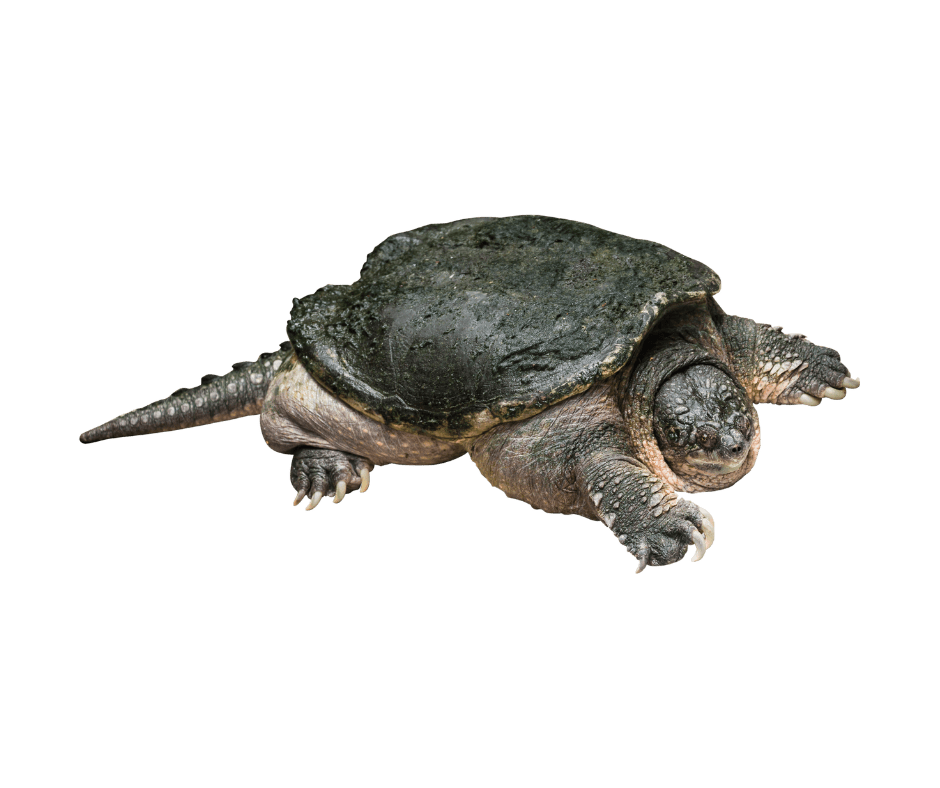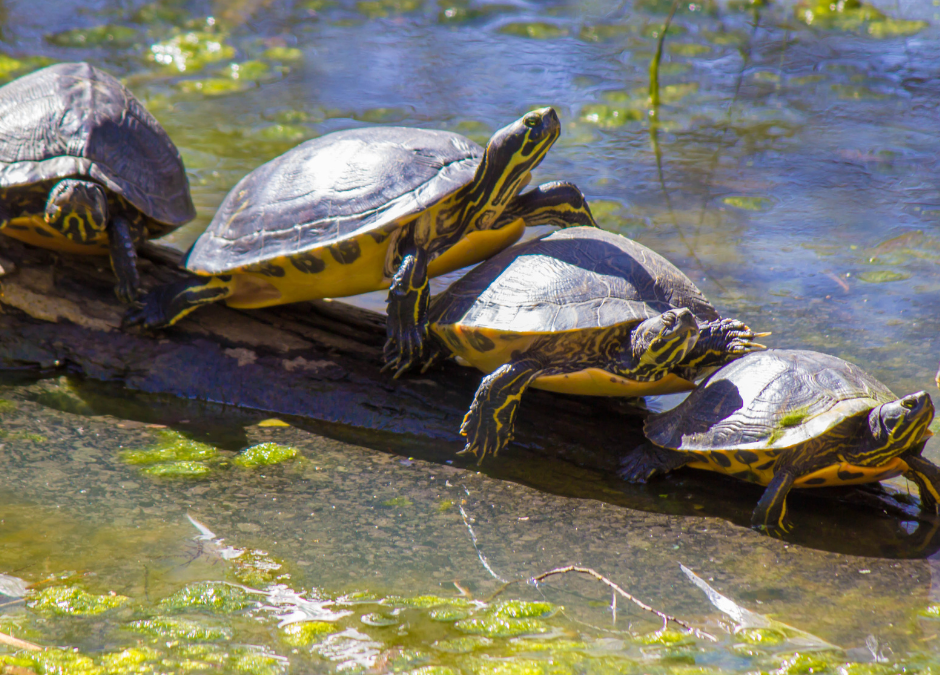I had a recent visitor who asked a very important question “Where do the turtles go in the winter?” Anyone who has spent any time on Lake Maxinkuckee in the summer knows we have a healthy turtle population. But where do they go in the winter? What do they eat and how do they survive?
Commonly Found Turtles in Lake Maxinkuckee

The Painted Turtle Chrysemys picta
One of the most common native turtles found in Indiana is the Painted Turtle. They are known for their affinity for basking in the sun, often seen perched on logs or rocks near the water. This is a common site on Lake Maxinkuckee in the summer.
Painted turtles are omnivores, meaning they eat both plants and animals and are bottom-dwelling hunters. They will quickly jut their head in and out of vegetation to stir potential victims out into the open water. Their webbed feet allow them to swim gracefully through the water pursuing the prey they stir up. They also eat plants and skim the surface of the water with an open mouth to catch small particles of food.

Softshell Turtle Apalone spp.
The Softshell Turtle is also commonly found in Indiana. Their shells are soft and leathery instead of a hard, bony shell like the Painted Turtle. They are primarily aquatic and are fantastic swimmers. Their streamlined body and long neck allow them to swiftly maneuver through the water.
Softshell Turtles bury themselves in the sand or mud at the bottom of the lake, leaving only their heads exposed. This allows them to ambush unsuspecting prey and hide from predators.

Snapping Turtle Chelydra serpentina
Snapping Turtles get their name from their powerful jaws and aggressive nature. They have a distinctive hook-like beak for capturing and devouring their prey. They are mainly aquatic but can be found on land, especially during nesting season. They also bury themselves in the mud on the bottom of the lake and wait for prey to swim by.

Turtles are Ectotherms or Cold-Blooded
Turtles are ectotherms, meaning their internal physiological sources of heat are relatively small or negligible in controlling their body temperature, and their internal temperature varies according to their surroundings. A turtle’s body temperature varies widely depending on whether they are basking in the sun or underwater. A human’s body temperature stays relatively stable, regardless of the surroundings.
Hibernation vs Brumation
Hibernation is defined as the condition or period, of an animal or plant, spending the winter in a dormant state. While turtles definitely slow down during the winter months, they are NOT dormant. They are still eating, breathing and can even be seen swimming under the ice! This is called brumation. Turtles brumate, not hibernate.
brumation
bru·ma·tion brü-ˈmā-shən
a state or condition of sluggishness, inactivity, or torpor exhibited by reptiles (such as snakes or lizards) during winter or extended periods of low temperature
Surviving the Winter
While submerged, a turtle’s blood-oxygen levels drop to near zero. They can survive like this for three to four months. With the same percentage of oxygen in our blood, humans would survive for three to four minutes.
Turtles rely on stored energy and “cloacal breathing” to survive the duration of winter, drawing oxygen from water as it passes over blood vessels in the skin, mouth and cloaca, or the hind end.
Kids love to learn that turtles can breathe through their butt!
If oxygen in the water becomes depleted, like it does when the lake is covered by ice and snow for an extended period of time, some turtles can switch to anaerobic respiration, meaning they don’t require oxygen. While necessary at times, anaerobic respiration can lead to a build-up of lactic acid and damage turtle tissue. To prevent damage, turtles’ skeletons and shells release carbonate buffers to neutralize lactic acid build-up. Once spring arrives, turtles are desperate to bask in sunlight, effectively increasing their metabolic rate and ridding their body of acidic by-products.
Painted Turtles are also one of the few species that are specially adapted to tolerate freezing temperatures for extended periods of time due to an antifreeze-like substance in their blood that keeps their cells from freezing.
Turtles aren’t so Tough!
Turtles face a surprising number of threats both in the U.S. and abroad — from illegal collection to habitat loss to pollution. They need our help.
- Habitat Loss and Fragmentation
Across the globe, habitat loss and fragmentation are the leading causes of wildlife declines. Turtles are no exception. Different turtle species evolved over millions of years to survive in a diversity of habitats, from wetlands to deserts. When the natural places they are adapted to become fragmented by development, degraded by pollution, or disappear entirely, turtles have nowhere else to go. If our Indiana wetlands continue to disappear, the turtles will too! - Roads and Collisions
Vehicles pose a significant threat to slow-moving turtles as they cross roads, especially in the springtime when turtles are looking for new territory, or mating opportunities. Explore tips for helping a turtle safely cross roads. - Mistreatment as Pets
Turtles need specialized care for decades, so be sure you are ready for a long-term commitment. They require specific food, temperature, and other conditions to survive. Do your research before buying a legal pet turtle to make sure you can care for it properly. Only certain turtles can be legally owned as pets – this varies by state.
How you can help turtles | U.S. Fish & Wildlife Service (fws.gov)

“Never discourage anyone who continually makes progress, no matter how slow.”
~ Plato

Hi, I’m Debbie Palmer. I received a BS in Horticulture from Purdue University. Here at LMEF, I am responsible for outreach presentations, monitoring the lake and it’s wetlands, project manager for restoration and research projects, and act as a community resource for all things related to the well-being of Lake Maxinkuckee and its surrounding watershed. I completed Indiana Watershed Leadership Academy, volunteer with the Indiana Clean Lakes Program, Hoosier River Watch and Marshall County Lakes and Waters and serve as a Board Member for Indiana Lakes Management Society.


Recent Comments